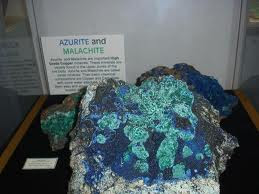

Mineral wealth is the natural occurrence of minerals, rock, or chemical compounds that might be economically exploited. It includes oil, natural gas, coal, salt, and ores.
People's need of large amounts of coal, gas, and oil is continually increasing, so that the growing population may maintain its high living standards. The question is, how long the required supply will last? What will happen, when the resources are exhausted? Where are these fuels located and what kind of burden on the environment do they represent? Our reserves at this time are deposits (exploitable accumulations of naturally occurring raw materials), which have been discovered and may be exploited.
The total occurrence of raw materials is called resources. Resources include known deposits, which are being exploited, then deposits, which may be exploited but need large investment of capital or new technology to do so, and deposits that have not been yet discovered, but according to estimates probably exist.
A great part of our resources is non-renewable, because these resources need many millions of years to form, but they may be exhausted within a few centuries. They are, in particular, solid fuel, such as coal and gas. For people, salt deposits, ores, and natural rock are also very important raw materials.
Since the beginning of the20th century, people have been trying to find alternate sources of these resources. Some of the examples is providing energy utilising the sunlight, or developing industrial manufacture of minerals.
Ore Deposits
Places containing a sufficient amount of minerals, which may be used to obtain metals, are called ore deposits, and minerals containing metals are called ore minerals. They are chemical compounds of metal elements combined with sulphur or oxygen. Ore in pure form is found very seldom, especially in larger pieces, they are combined generally with rock minerals, which are also important for us. Some precious or heavy metals, for example gold, occur naturally in the form of elements.
A valuable raw material is obtained by separating the ore from the host rock. A deposit is economically viable only if a certain element occurs in a substantially higher concentration than in the average rock of the earth's crust.
Deposits are formed by various geological processes. There are sedimentary, igneous, and hydrothermal deposits.
Sedimentary deposits are among the most important raw material resources on earth. Through chemical and physical action during the sedimentation process, many economically important minerals were separated. The most important factor in this case is the dissolving property of water. An example of this process are the silica sands. The water currents and waves change sands to such a degree, that only pure quartz is left behind. Quartz is an important raw material in the glass industry and for the telecommunications technology (fibre optics).
Copper, iron, and other metals are also important sedimentary ore deposits. The most important ores are found in the Precambrian sedimentary rock. There are large deposits of this type in Brazil, India, Australia, and North America.
Ore deposits with a high content of gold or other heavy metals, for example titanium minerals, are called placer deposits.
A well-known method of obtaining gold is the panning. By swirling a pan filled with fluvial deposits, one first separates the lighter minerals, because the heavy gold settles on the bottom of the pan.
Diamond, one of the most valuable minerals, comes to the earth's surface through thin, long tubes. Diamonds form in the depth of the upper earth's mantle, because only there the pressures are such as to allow the formation of this mineral.
Igneous deposits often occur in layers. They form, when minerals crystallise from the molten magma, sink, and are enriched on the bottom of the igneous chamber. In southern Africa, important deposits of platinum and chromium were find in this type of deposits.
Hydrothermal deposits form thanks to the action of hot solutions during magma melting processes, or in the hot underground water.
Minerals are separated by the hot liquids from the rock and when they are transported to cooler rocks, they settle in the cracks and cavities. This is how iron sulphides, zinc, and copper form.
If the hydrothermal solutions reach the earth's surface, it gives rise to hot springs and geysers containing mercury and zinc. Large hydrothermal deposits are found for example in the Mississippi river basin in Kansas and Oklahoma.
www.made-from-india.com maintains a database for Metals Products manufacturers, exporters, suppliers, importers and wholesalers of mineral & metal products. This consists of asbestos & asbestos products, aluminum, aluminum products, copper & copper products, diamonds-polished, ferroalloy & products, iron & steel castings, iron & steel products, lead & lead products, magnetic materials, metal waste, mining machinery, wire mesh, wire ropes and zinc & zinc products, copper mineral, aluminum mineral, mineral properties, titanium mineral, mineral gemstones, industry metals, Mineral & metals buyers, mineral & metals seller, global minerals and metals, etc.
No comments:
Post a Comment